

Ecological Impact
Bottom trawl impacts on benthic habitat
Heavy trawling gear inevitably disturbs benthic biota and substrate. Because availability and quality of habitat affects the productivity of fish stocks, there is worldwide concern about these disturbances (Dieter, Wion and McConnaughey 2003). How severe and lasting are these effects on benthic habitats and the associated fish stocks?
Our TRAWLEX program is addressing this question with experiments that measure both the long-term (chronic) and short-term (acute) effects of bottom trawls on eastern Bering Sea (EBS) benthos. Long-term effects have been identified by comparing conditions in heavily trawled (HT) and untrawled (UT) areas (McConnaughey et al., 2000; 2005). Invertebrate taxa were collected at paired sites straddling the boundary of the Crab and Halibut Protection Zone 1 (CHPZ1) closure area in Bristol Bay. The study area is shallow (44–52 m) with a sandy substrate, ubiquitous bottom ripples, and strong tidal currents. Our analyses indicate that (1) sedentary macrofauna (e.g., anemones, soft corals, sponges, whelk eggs, bryozoans, ascidians), neptunid whelks, and empty shells were more abundant in the UT area; (2) mixed effects were observed within motile groups (e.g. crabs, sea stars, whelks) and infaunal bivalves, suggesting the importance of life history characteristics; and (3) overall diversity and niche breadth of sedentary taxa were greater in the UT area.
Although chronic bottom trawling typically reduces benthic biomass, it is generally unknown whether this represents a decrease in numbers of individuals or their mean body size. Additional analyses with 16 invertebrate taxa found that mean body sizes (kg) of 15 taxa were smaller in the HT area, however the HT-UT differences were small relative to natural variability in the surrounding EBS. Red king crab was the one exception; mean body size was greater in the UT area due to relatively fewer small specimens.
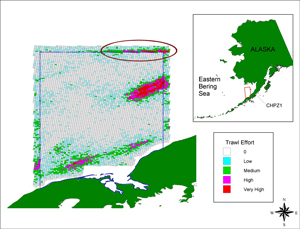 
Study area for TRAWLEX investigation of long-term bottom trawling effects.
Comparative sampling was conducted in heavily fished and unfished areas
straddling the northeastern boundary of the CHPZ1 no-trawl zone.
|
The TRAWLEX program is also investigating short-term effects and recovery in a multi-year process-oriented study with a Before-After Control-Impact (BACI) experimental design. During a 35-day cruise in 2001, 6 pairs of predesignated 10-mi long research corridors were sampled before and after a trawling disturbance with commercial gear (NETS 91/140 Aleutian cod combination). Quantitative assessments of epifauna and infauna populations were undertaken before and after trawling. |

van Veen sediment grab |
|
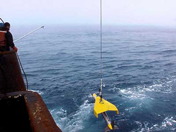
Klein 5410 in deployment
|
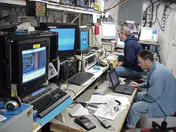
Shipboard sonar room |
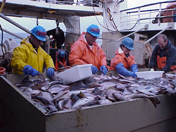
Bottom trawl catch |
The corridors were revisited in 2002 to monitor recovery. Preparations are underway to conduct the final sampling event in Summer 2009. Measures of the persistence and degree of trawling effects that will be analyzed include changes in physical/chemical properties of the seabed, quantity and structure of habitat cover, and variability in size and numbers of benthic invertebrates.
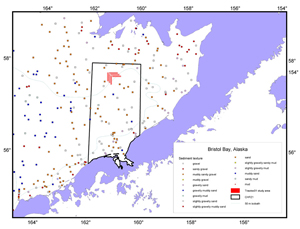 
Study area for TRAWLEX investigation of short-term bottom
trawling effects and recovery. A commercial trawl was used
to disturb 6 of the 12 research corridors shown in red.
|